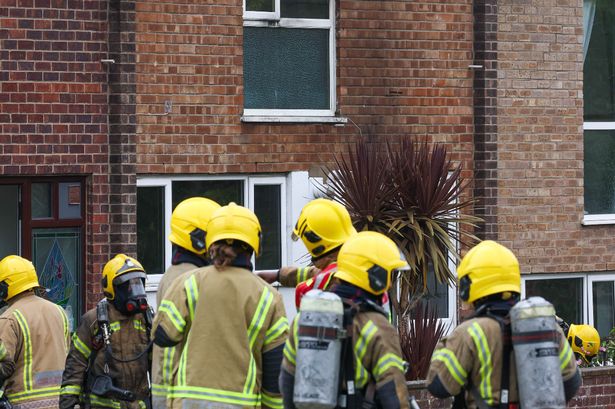It’s been the subject of much debate among residents Fire and ambulance crews at the scene of a house fire in Barton Hill on the morning of Wednesday, August 13, 2025(Image: PAUL GILLIS / Reach PLC)
Fire and ambulance crews at the scene of a house fire in Barton Hill on the morning of Wednesday, August 13, 2025(Image: PAUL GILLIS / Reach PLC)
A blaze at a property on Cabot Green in Barton Hill has started some fierce comments by the readers of Bristol Live over whether the East Bristol Liveable Neighbourhood (EBLN) hampered fire crews’ response times.
Fire chiefs in Bristol have played down claims by local residents that fire crews were delayed reaching a house fire in East Bristol by roadblocks created as part of the local ‘Liveable Neighbourhood’ trial.
The incident occurred at 11.25am on Wednesday, right in the heart of an area transformed by new traffic restrictions, bollards and a pocket park.
Avon Fire and Rescue Service confirmed its first appliance arrived at the scene “within our response standard of eight minutes”.
The service also stated that crews carry maps of local traffic measures on their mobile data terminals and have access to bollard codes, and that it collaborates with Bristol City Council to guarantee emergency access.
The fire was determined to be accidental with no reported injuries.
What transpired during those crucial minutes between the initial 999 calls and the arrival of Avon Fire and Rescue Service engines at the fire scene has become the focus of speculation.
The primary Ducie Road runs past that green triangle, approaching from Church Road before meeting a T-junction with Morley Street and Barton Hill Road, on the corner beside the Wellspring Settlement.
There are two points in this vicinity where the East Bristol Liveable Neighbourhood has blocked roads to vehicle access.
At that T-junction, all routes are barred to vehicles and Bristol City Council has created a ‘pocket park’, directly opposite the house that caught fire on Wednesday morning. Just over 100 yards to the north west, where Ducie Road crosses the railway line behind the Cabot Green homes, the city council has positioned a metal bollard in the centre of the carriageway to prevent vehicle access, whilst permitting motorcycles, bicycles and scooters to pass through.
Emergency services can unlock and lower the bollard using an access code.
One reader, Rrrriiigggghhhhtttt, remarks: “It is terribly sad that somebody’s house caught fire. However, hopefully this story can now be used as an example of how liveable neighbourhoods have no impact on emergency services, which is the bedrock of the argument for those who are opposed to it.”
Bs3bob feels: “The fire brigade ‘played it down’, what they didn’t say is ‘I didn’t slow out response time’. From the sounds of it they could have got there quicker if the EBLN wasn’t a thing. Whether that would have made a difference in this case, possibly not, but any delay could do in the future.”
Culturalattache comments: “Please be aware that Avon Fire and Rescue service played down suggestions that the EBLN infrastructure delayed them. There is NO EVIDENCE to indicate that the EBLN played any part in affecting the response and access time. However, many of those irrationally opposed to the EBLN will continue to make pointless and pessimistic speculation.”
BMushroom adds: “Agreed. It’s obvious that unlocking a bollard takes more time than simply continuing to drive. Therefore it was delayed by the EBLN.”
Bs3bob replies: “The fire brigade could have easily said that the bollards and other EBLN made no difference to the response time. They didn’t. ‘Playing it down’ means they didn’t think any extra time – even if it was only a short time, made a difference, not that they weren’t delayed. As for ‘no evidence’, doesn’t the article state that residents had to guide the engine crews?”
Misterurb says: “In this instance a few seconds delay may not have had any measurable difference to the outcome however if there was someone trapped needing rescue a few seconds could be the difference between life and death. Could having a couple of e-scooters on board make it possible to get a bollard down ahead of the vehicle making it no longer an issue!”
Do you believe that in this instance, the EBLN did indeed slow down the response from the fire brigade? Have your say by commenting below or HERE to join in the conversation.
